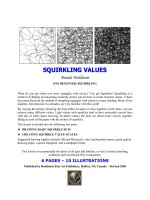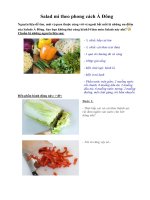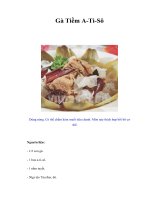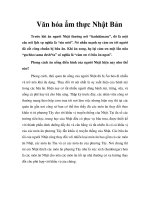Squirkling a Bumpy Texture
Bạn đang xem bản rút gọn của tài liệu. Xem và tải ngay bản đầy đủ của tài liệu tại đây (1.27 MB, 9 trang )
Brenda Hoddinott
D-10 BEGINNER: SQUIRKLING
In the real world, very few objects have actual
lines defining their forms. Rather, contrasting
values identify the edges of the object’s parts
according to the lights and darks created by
the dominant light source.
This lesson focuses on values and forms rather than lines and shapes. You use squirkles to draw
the wonderful bumpy texture of an avocado with shading only – no outlining.
This lesson is divided into the following two sections:
Ü FINDING THE POSITIVE: You examine a reference photo, identify the negative space,
and single out the avocado, as both positive space and the future subject of the drawing.
Ü ADDING VALUES AND TEXTURE WITH SQUIRKLES: Each of the five illustrated
steps is on its own page, along with close-up views of a section of the drawing in progress
and the original reference photo. The light source is from the upper left. Hence, the values
are lighter on the upper and left sections.
You need 2H (very good for light values), HB (great for middle values), and 2B (works well for
dark values) mechanical pencils, good quality drawing paper, and erasers. If you plan to use
regular wood pencils instead of mechanical, you also need a pencil sharpener and a sandpaper
block.
This lesson is recommended for beginners, and artists wanting to review or expand upon their
current skills, as well as home schooling, academic and recreational fine art educators.
9 PAGES – 17 ILLUSTRATIONS
Published by Hoddinott Fine Art Publishers, Halifax, NS, Canada - 2006
Copyright to all articles, images, text, projects, lessons and exercises within this drawing class belong to Brenda Hoddinott and may
not be reproduced or used for any commercial purposes whatsoever without the written permission of Brenda Hoddinott.
Web sites and
2
FINDING THE POSITIVE
In the interest of simplicity, the subject of this drawing is the avocado only, without a
background, cast shadow, or other visual distractions. Cast shadow is a dark section on an object
or/and surface that receives little or no light.
In this section, you examine a reference photo, identify the negative space, and single out the
avocado, as both positive space and the future subject of the drawing. Negative space refers to
the background around and/or behind the drawing subject(s), such as the sky, a scene, the interior
of a building, objects, people, and/or animals (etc.). Positive space refers to the space occupied
by the drawing subject(s) and/or its (or their) various parts.
This lesson focuses on values and forms rather than lines and shapes. Values are the different
shades of gray created in a drawing by various means. Forms are created in drawings by adding
shading to transform a shape into three-dimensional structures, such as a circle becoming a
sphere. Lines visually separate and/or define the forms of the various components of a drawing
subject. Shape refers to the outward outline of a form. Basic shapes include circles, squares and
triangles.
Even outlining the basic proportions before adding shading, is a no-no in this project. Proportion
is the relationship in size of one component of a drawing to another or others. Shading (noun)
refers to the various values in a drawing that make images appear three-dimensional; (verb) the
process of adding values to a drawing so as to create the illusion of texture, form and/or three-
dimensional space.
After examining the photo (Illustration 10-01), I decide to visually focus on only the avocado
(positive space). To show you what I see, I use a computer program to block out all sections of
the photo that are not part of the avocado (negative space). Check out the negative space (the
black section) in Illustration 10-02.
ILLUSTRATION 10-01 ILLUSTRATION 10-02
No visible lines actually outline this avocado in the reference photo or the completed drawing
(refer to illustrations 10-03 and 10-04). Rather, contrasting values define the edges of the
object’s parts and its bumpy texture. Texture refers to the surface detail of an object in a drawing.
The properties of a texture are identified with vision, a sense of touch, and a general knowledge
of the subject.
Copyright to all articles, images, text, projects, lessons and exercises within this drawing class belong to Brenda Hoddinott and may
not be reproduced or used for any commercial purposes whatsoever without the written permission of Brenda Hoddinott.
Web sites and
3
My goal is to render form and texture. I won’t be fussing with drawing every bump in its correct
place. Rather, I will try to capture the essence of the surface bumps, as simply as possible.
ILLUSTRATION 10-03 ILLUSTRATION 10-04
ADDING VALUES AND TEXTURE WITH SQUIRKLES
Squirkling is a method of shading in which randomly drawn, overlapping curved lines create
textured values. I chose this name based on the process of morphing squiggles with circles to
create shading. Many of my students from the past two decades are very familiar with this word!
If you are using regular pencils, make sure you sharpen the point of the pencil with a sharpener
and/or sandpaper block after each section of shading is added.
Examine the light, medium and dark values in the following close-ups of sections of the
completed drawing. By varying the density (drawing the lines either far apart or close together)
of the lines, you can achieve many different values. Light values with squirkles tend to have
noticeable curved lines with lots of white space showing. In darker values, the lines are closer
together, filling in most of the paper with the texture of squirkles. A 2H pencil is very good for
light values, an HB is great for middle values, and a 2B works well for dark values.
ILLUSTRATION 10-05 ILLUSTRATION 10-06 ILLUSTRATION 10-07
Each of the seven illustrated steps of this lesson is on its own page, along with close-up views of
a section of the drawing in progress and the original reference photo.
Copyright to all articles, images, text, projects, lessons and exercises within this drawing class belong to Brenda Hoddinott and may
not be reproduced or used for any commercial purposes whatsoever without the written permission of Brenda Hoddinott.
Web sites and
4
ILLUSTRATION 10-08
1. Use squirkling and press very
lightly with a 2H pencil, to
render the lightest values.
Your goal is to draw the overall
mass of the avocado. Observe
how the squirkle lines cut across
themselves in many places,
creating lots of different shapes.
ILLUSTRATION 10-09
My actual drawing is
even lighter than in this
illustration. I’ve made it
darker in a computer so
you can see it.
The less pressure
you apply to the
pencil, the lighter
the values become.
In my lightest
shading, only the
weight of the pencil
itself makes the
very faint values.
You can keep adjusting
the overall shape as you
work, by erasing sections
that are too big, and
adding more squirkles to
make some sections
larger.
Copyright to all articles, images, text, projects, lessons and exercises within this drawing class belong to Brenda Hoddinott and may
not be reproduced or used for any commercial purposes whatsoever without the written permission of Brenda Hoddinott.
Web sites and
5
ILLUSTRATION 10-10
2. Press a little more on your 2H
pencil to add darker values.
The light source is from the upper
left. Hence, the values are lighter
on the upper and left sections.
ILLUSTRATION 10-11
Light source refers to
the direction from
which a dominant light
originates.
A light source
identifies the light
and shadow areas
of a drawing
subject, so artists
know where to
add different
values.
As you complete
each section,
continuously go
back over your
drawing and adjust
the values.
To make a section lighter,
pat the squirkles gently
with a kneaded eraser that
is molded to a point.
To make a section darker, simply add more
squirkles and/or use a darker pencil.









